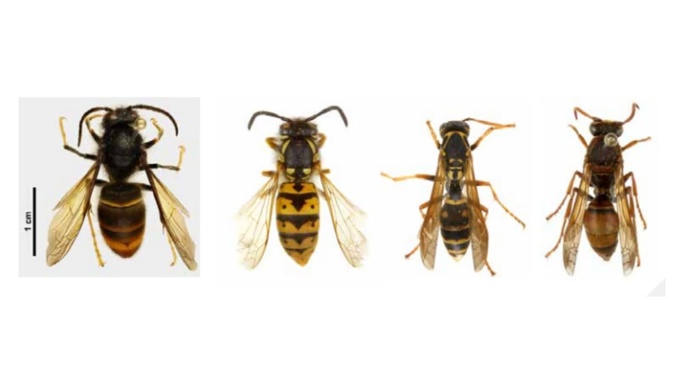
Biosecurity New Zealand is urging Aucklanders to look out for yellow-legged hornets after the discovery of a queen hornet on the North Shore.
On October 17 biosecurity officers removed a nest of yellow-legged hornets (Vespa velutina) in Glenfield.
The pest was not known to be in NZ. The yellow-legged hornet presents a biosecurity concern due to its potential impact on honey and wild bee populations.
Mike Inglis, North commissioner, Biosecurity NZ said the nest was in the early stages of forming, meaning the immediate threat of a colony establishing was dealt with. However, with summer approaching, any undetected nests could be a biosecurity risk.
“This is the first time we’ve found a queen yellow-legged hornet in NZ,” Inglis says.
“We responded quickly to this threat, but we need the public’s help to eliminate any further risk.”

Yellow-legged hornet characteristics - a queen has been found in NZ for the first time. Photo / Buckeye Yard & Garden, Ohio State University.
Inglis says the hornet is “a highly adaptable predator with a broad diet, primarily feeding on bees, wasps, and flies, but also ripe fruit and flower nectar, posing a risk to growers.
“It may compete with native insects and birds for food, and it has a painful sting.”
Female hornets will protect themselves by stinging, and can sting repeatedly. Getting too close to a hornet nest or disturbing them in flight may result in attack.
If you are stung and experience shortness of breath, a rash or pronounced swelling, seek medical attention immediately. If you are stung on the mouth, face or neck, or if pain and swelling persist for a few days, seek medical advice.
Two male yellow-legged hornets were spotted earlier this year in Grafton and Albany.
“New Zealand is fortunate to be free of hornet populations, and we want it to stay that way,” Inglis says.
Following the discovery, Biosecurity NZ say they want to hear from anyone who has seen the insect.
What does a hornet look like?
The yellow-legged hornet is large, (2cm to 3cm long) with a black head and a yellow face, black thorax, and legs with black femur and tibia and yellow tarsis.
Between the first and second abdominal segment is a narrow yellow band, and the fourth abdominal segment is yellow, with the remainder being black or dark brown. Unlike other common wasps the wings of a hornet are a smoky brown colour and not transparent.
A hornet is a type of wasp. There are five species of social wasps currently established in NZ. These wasps are all much smaller than the yellow-legged hornet, measuring between 11 mm and 16 mm.

Yellow-legged hornet (far left) compared to species established in New Zealand: (from left to right) German wasp (Vespula germanica), Asian paper wasp (Polistes chinensis) and Australian paper wasp (Polistes humilis). Photo / Biosecurity New Zealand
What does a yellow-legged hornet nest look like?
Yellow-legged hornets construct large nests up to 60cm wide to 80cm tall, usually high up in trees or under the eaves of buildings.
It suspends many layers of cells together and “wraps them up” to form a football sized structure.
Chinese and Australian paper wasps also like to construct aerial nests in similar locations to the hornet. However, they can be easily distinguished from hornet nests as the cells of paper wasp nests have open rather than wrapped cells.
German and common wasps (established in NZ) construct large nests that look quite similar to that of the hornet nest, but these are usually built under ground. If the nest is constructed above ground, they are not usually attached to branches of trees and shrubs.
What to do if you spot a yellow-legged hornet
Members of the public are asked to report any sightings of suspected hornets or hornet nests online, or by calling Biosecurity NZ’s exotic pest and disease hotline on 0800 809 966.
Do not disturb a nest if you see one, instead photograph it and contact Biosecurity NZ.
Take your Radio, Podcasts and Music with you









